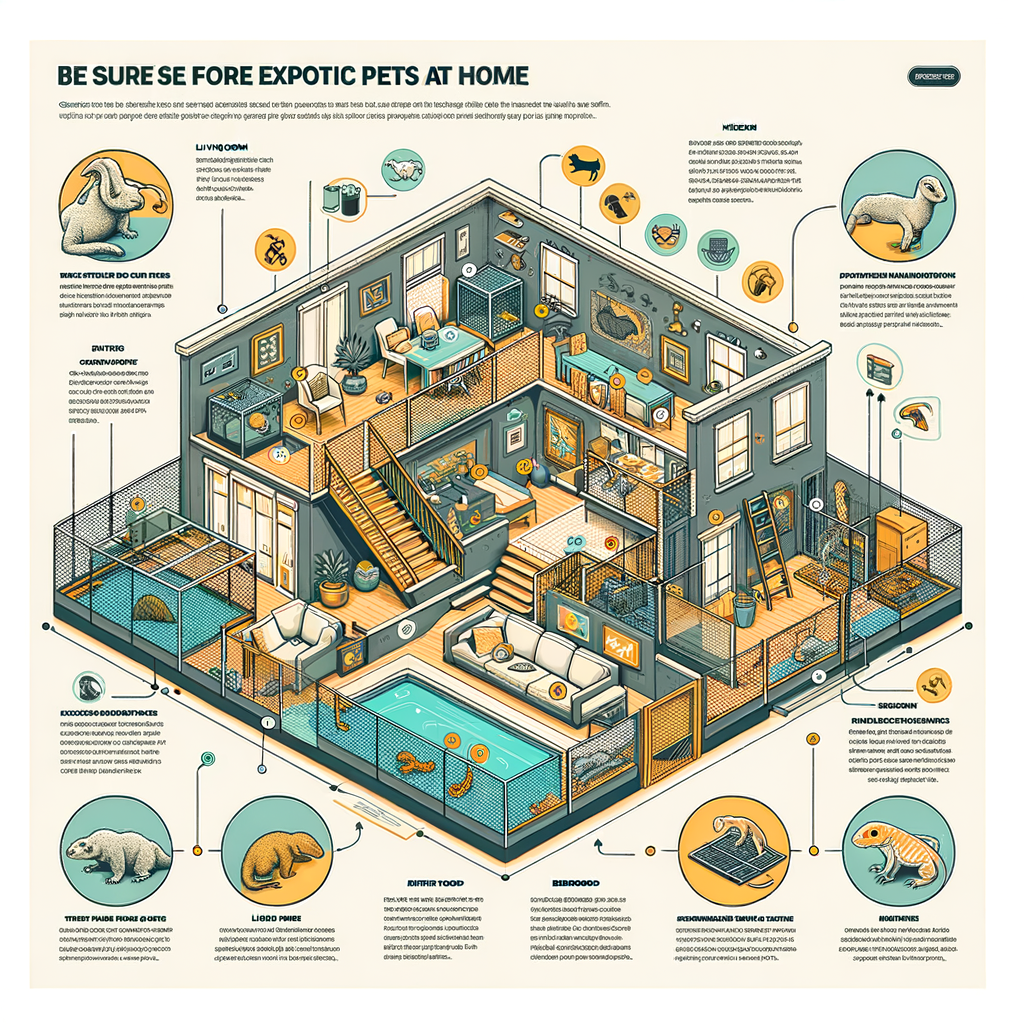
Introduction to Exotic Pet Safety
Welcome to our comprehensive guide on exotic pet safety. Exotic pets, unlike common domestic animals like dogs and cats, have unique needs and require special care and attention. In this guide, we will explore the importance of understanding these needs and creating a safe environment for your exotic pets.
- Understanding the Unique Needs of Exotic Pets
- Importance of Creating a Safe Environment for Exotic Pets
Exotic pets, such as reptiles, birds, and small mammals, have unique needs that differ greatly from traditional pets. For instance, many exotic pets require specific diets, habitats, and care routines to stay healthy and happy. Some exotic pets, like certain reptiles, need specific lighting and temperature conditions to thrive. Others, like certain bird species, need mental stimulation and social interaction.
Understanding these unique needs is the first step towards ensuring your exotic pet’s safety. It’s crucial to research and learn about your pet’s natural habitat, diet, and behavior. This knowledge will help you provide the best care for your pet and prevent potential health issues.
Creating a safe environment for your exotic pet is just as important as understanding its unique needs. This involves pet-proofing your home, setting up a suitable habitat, and regularly checking for potential hazards.
For example, some exotic pets can easily escape from their enclosures if they’re not secure enough. Others might be sensitive to certain household products or foods. By creating a safe environment, you can prevent accidents and ensure your pet’s wellbeing.
In the following sections, we will delve deeper into how to pet-proof your home for exotic pets and provide more detailed information on exotic animal care and safety. Stay tuned to learn more about how to keep your exotic pet safe and healthy.
Pet-Proofing Your Home for Exotic Pets
Exotic pets are unique and fascinating creatures, but they also require special care and attention. One of the most important aspects of owning an exotic pet is ensuring your home is safe for them. Here are some general tips to help you pet-proof your home.
General Pet-Proofing Tips
Whether you have a snake, a parrot, or a sugar glider, there are some general safety measures you should take to ensure your pet’s well-being.
- Securing windows and doors
- Removing toxic plants
- Managing wires and small objects
Exotic pets are often curious and may try to escape through windows or doors. Ensure all windows and doors are secure and cannot be opened by your pet. This includes checking for gaps or cracks that a small creature could squeeze through.
Many common houseplants can be toxic to pets if ingested. Research which plants are safe for your specific pet and remove any potentially harmful ones from your home.
Small objects and electrical wires can pose a choking hazard or risk of electrocution for your pet. Keep these items out of reach or securely covered to prevent accidents.
Remember, each type of exotic pet has its own specific needs and sensitivities. Always do your research and consult with a vet to ensure you’re providing the safest environment possible for your pet.
Specific Home Modifications for Exotic Pets
When it comes to exotic pets, their needs are as unique as they are. A one-size-fits-all approach won’t work, and you’ll need to make specific modifications to your home to ensure their safety and comfort. Let’s explore some of these modifications.
- Creating a Safe Exotic Pet Habitat
- Temperature and Humidity Control
- Proper Lighting for Exotic Pets
The first step in creating a safe environment for your exotic pet is to design a habitat that mimics their natural surroundings. This involves researching your pet’s native environment and replicating it as closely as possible. For instance, if your pet is a tree-dwelling creature, providing vertical spaces for climbing is essential. On the other hand, burrowing animals will require a habitat with ample space for digging. Always ensure there are no sharp edges or small objects that your pet could swallow.
Exotic pets often come from climates very different from ours. As such, maintaining the right temperature and humidity levels in their habitat is crucial. For example, reptiles like snakes and lizards need a heat source in their enclosure to help regulate their body temperature. On the other hand, tropical pets such as certain bird species or amphibians require high humidity levels. Invest in a good quality thermometer and hygrometer to monitor these conditions.
Lighting is another critical factor in your exotic pet’s habitat. Many exotic pets need specific light conditions to thrive. For instance, reptiles need exposure to UVA and UVB light to synthesize vitamin D and absorb calcium. Birds, on the other hand, require full-spectrum lighting to mimic natural sunlight. Always research your pet’s specific lighting needs and provide the appropriate light fixtures in their habitat.
In conclusion, creating a safe and comfortable environment for your exotic pet involves careful planning and specific home modifications. By taking the time to understand your pet’s unique needs, you can create a habitat that not only keeps them safe but also helps them thrive.
Exotic Animal Care and Safety
When it comes to caring for exotic pets, it’s crucial to understand their unique needs and requirements. One of the most important aspects of exotic pet care is their diet and nutrition. Let’s delve into this topic further.
Feeding and Nutrition
Feeding your exotic pet properly is one of the most important aspects of their care. It’s not just about what you feed them, but also how much and when. Let’s explore this in more detail.
- Understanding the dietary needs of your exotic pet
- Safe and harmful foods for exotic pets
Every exotic pet has different dietary needs. Some are herbivores, some are carnivores, and some are omnivores. For instance, a sugar glider needs a diet rich in fruits, vegetables, and insects, while a chinchilla requires a diet high in fiber, like hay and pellets. It’s essential to research and understand what your specific pet needs to stay healthy and thrive.
Just as there are foods that are beneficial for your exotic pet, there are also foods that can be harmful. For example, avocados and chocolate are toxic to many animals. On the other hand, fruits and vegetables are generally safe for most exotic pets, but it’s always best to check with a vet or do thorough research. Remember, what’s safe for one pet may not be safe for another.
Feeding your exotic pet the right foods in the right amounts is crucial for their health and longevity. Always do your research and consult with a vet if you’re unsure about anything. Remember, a well-fed pet is a happy and healthy pet!
Conclusion
Exotic pet care can be a rewarding experience, but it also comes with its unique challenges. By understanding your pet’s dietary needs and knowing which foods are safe and harmful, you can ensure that your pet stays healthy and happy. Remember, every pet is unique, so what works for one might not work for another. Always do your research and consult with a professional if you’re unsure.
Exotic Animal Care and Safety
Health and Wellness
- Regular veterinary check-ups: Just like humans, exotic pets need regular health check-ups. A vet who specializes in exotic pets can help keep your pet healthy and happy. Regular check-ups can catch health problems early before they become serious.
- Recognizing signs of illness in exotic pets: It’s important to know the signs of illness in your exotic pet. Some signs might include changes in behavior, eating habits, or physical appearance. If you notice anything unusual, it’s best to consult with a vet right away.
- Researching your pet’s natural habitat: Understanding your pet’s natural habitat can help you provide the best care. This includes knowing what kind of food they eat, their preferred climate, and their typical behaviors. The more you know about your pet’s natural habitat, the better you can recreate it at home.
- Setting up the habitat before bringing the pet home: Before you bring your exotic pet home, make sure their habitat is ready. This includes setting up the right temperature, humidity, and lighting, as well as providing the right food and water. A well-prepared habitat can help your pet adjust to their new home more easily.
- Introducing your pet to its new home: When you first bring your pet home, give them time to adjust. Introduce them to their new habitat slowly and gently. Remember, this is a big change for them, so be patient and understanding.
- Success stories of pet-proofing homes: Many pet owners have successfully pet-proofed their homes to keep their exotic pets safe. This might include securing windows and doors, removing toxic plants, and providing safe play areas. These success stories can provide inspiration and practical tips for other pet owners.
- Lessons learned from exotic pet accidents: Unfortunately, accidents can happen. But we can learn from these incidents to prevent similar accidents in the future. Some common lessons include the importance of secure enclosures, careful handling, and regular health check-ups.
- Revisiting the importance of a safe environment for exotic pets: A safe environment is crucial for your pet’s health and well-being. This includes not only the physical environment, but also the emotional environment. Your pet needs to feel safe and secure in their new home.
- Continuing education on exotic pet care: Caring for an exotic pet is a lifelong learning process. There are always new research findings, best practices, and care tips to learn. Continuing education can help you provide the best possible care for your pet.








